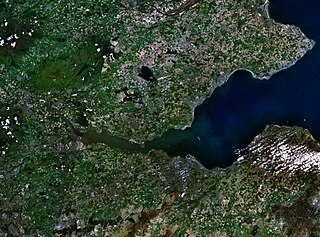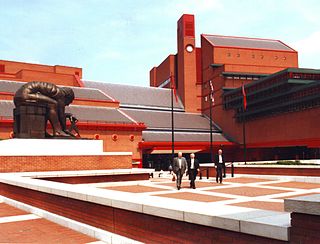Related Research Articles

William Dunbar was a Scottish makar poet active in the late fifteenth century and the early sixteenth century. He was closely associated with the court of King James IV and produced a large body of work in Scots distinguished by its great variation in themes and literary styles. He was likely a native of East Lothian, as assumed from a satirical reference in The Flyting of Dumbar and Kennedie. His surname is also spelt Dumbar.

The Gutenberg Bible was among the earliest major books printed using mass-produced movable metal type in Europe. It marked the start of the "Gutenberg Revolution" and the age of printed books in the West. The book is valued and revered for its high aesthetic and artistic qualities as well as its historic significance. It is an edition of the Latin Vulgate printed in the 1450s by Johannes Gutenberg in Mainz, in present-day Germany. Forty-nine copies have survived. They are thought to be among the world's most valuable books, although no complete copy has been sold since 1978. In March 1455, the future Pope Pius II wrote that he had seen pages from the Gutenberg Bible displayed in Frankfurt to promote the edition, and that either 158 or 180 copies had been printed.

Robert Henryson was a poet who flourished in Scotland in the period c. 1460–1500. Counted among the Scots makars, he lived in the royal burgh of Dunfermline and is a distinctive voice in the Northern Renaissance at a time when the culture was on a cusp between medieval and renaissance sensibilities. Little is known of his life, but evidence suggests that he was a teacher who had training in law and the humanities, that he had a connection with Dunfermline Abbey and that he may also have been associated for a period with Glasgow University. His poetry was composed in Middle Scots at a time when this was the state language. His writing consists mainly of narrative works. His surviving body of work amounts to almost 5000 lines.

The history of the books became an acknowledged academic discipline in the 1980s, Contributors to the discipline include specialists from the fields of textual scholarship, codicology, bibliography, philology, palaeography, art history, social history and cultural history. Its key purpose is to demonstrate that the book as an object, not just the text contained within it, is a conduit of interaction between readers and words.

Woodblock printing or block printing is a technique for printing text, images or patterns used widely throughout East Asia and originating in China in antiquity as a method of printing on textiles and later paper. As a method of printing on cloth, the earliest surviving examples from China date to before 220 AD. Woodblock printing existed in Tang China by the 7th century AD and remained the most common East Asian method of printing books and other texts, as well as images, until the 19th century. Ukiyo-e is the best-known type of Japanese woodblock art print. Most European uses of the technique for printing images on paper are covered by the art term woodcut, except for the block-books produced mainly in the 15th century.

The National Széchényi Library (OSZK) is a library in Budapest, Hungary. It is one of two Hungarian national libraries, the other being University of Debrecen Library.
The Edinburgh Courant was a broadsheet newspaper from the 18th century. It was published out of Edinburgh, Midlothian, Scotland. Its first issue was dated February 14–19, 1705 and was sold for a penny. It was Scotland's first regional newspaper and it was produced twice weekly for five years, thereafter continuing as the Scots Courant until April 1720.

The global spread of the printing press began with the invention of the printing press with movable type by Johannes Gutenberg in Mainz, Germany c. 1439. Western printing technology was adopted in all world regions by the end of the 19th century, displacing the manuscript and block printing.

The Aberdeen Breviary is a 16th-century Scottish Catholic breviary. It was the first book to be printed in Edinburgh, and in Scotland.

The British Library is the national library of the United Kingdom and is one of the largest libraries in the world. It is estimated to contain between 170–200 million items from many countries. As a legal deposit library, the British Library receives copies of all books produced in the United Kingdom and Ireland, including a significant proportion of overseas titles distributed in the UK. The Library is a non-departmental public body sponsored by the Department for Digital, Culture, Media and Sport.
The Actes and Deidis of the Illustre and Vallyeant Campioun Schir William Wallace, also known as The Wallace, is a long "romantic biographical" poem by the fifteenth-century Scottish makar of the name Blind Harry probably at some time in the decade before 1488. As the title suggests, it commemorates and eulogises the life and actions of the Scottish freedom fighter William Wallace who lived a century and a half earlier. The poem is historically inaccurate, and mentions several events that never happened. For several hundred years following its publication, The Wallace was the second most popular book in Scotland after the Bible.
Alexander Donaldson was a Scottish bookseller, publisher, and printer. Donaldson was the founding publisher of the weekly newspaper, the Edinburgh Advertiser. He was also known for selling cheap copies of books after their copyright had expired in disregard to London booksellers' opinions on literary property.
The Knightly Tale of Gologras and Gawain is a Middle Scots Arthurian romance written in alliterative verse of 1362 lines, known solely from a printed edition of 1508 in the possession of the National Library of Scotland. No manuscript copy of this lively and exciting tale has survived.
The UK Memory of the World Register is part of the Memory of the World Programme.

Androw Myllar was the first Scottish printer.

The Chepman and Myllar Press was the first printing press to be established in Scotland.

Central Library in Edinburgh, Scotland, opened in 1890, was the first public library building in the city. Edinburgh Central library comprises six libraries: Lending, Reference, Music, Art and Design, Edinburgh and Scottish and the Children's Library.

Walter Chepman was a Scottish merchant, notary and civil servant active in the late fifteenth and early sixteenth centuries. Chepman served at the Scottish court during the reigns of James IV and James V. In partnership with Androw Myllar he established Scotland's first printing press in 1508. Chepman was also a significant patron of Saint Giles' Kirk in Edinburgh.

Poems, Chiefly in the Scottish Dialect is commonly known as the first Edinburgh Edition and the partial second setting has become known as the Stinking Edition. It is a collection of poetry and songs by Robert Burns, first Printed for the Author by William Smellie in Edinburgh and published or Sold by William Creech of Edinburgh on the 17 April, an announcement being made in the Edinburgh Advertiser on that date, although the date 21 April 1786 is given by a few authors. The Kilmarnock Edition made Robert Burns Caledonia's Bard whilst the 'Edinburgh Edition' elevated him into a position amongst the world's greatest poets.
References
- ↑ "Printing is one of Scotland's oldest surviving industries". 500 Years of Printing in Scotland. Retrieved 14 July 2010.
- ↑ Ross, ShãN (14 July 2010). "World won't forget Scotland's rich past". Edinburgh: The Scotsman. Retrieved 14 July 2010.
- ↑ "The Chepman and Myllar prints". National Library of Scotland. Retrieved 14 July 2010.